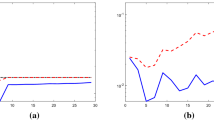Abstract
An approach is proposed to the stable solution of discrete ill-posed problems on the basis of a combination of random projection of the initial ill-conditioned matrix with an ill-defined numerical rank and the pseudo-inversion of the resultant matrix. To select the dimension of the projection matrix, we propose to use criteria for the selection of a model and a regularization parameter. The results of experimental studies based on the well-known examples of discrete ill-posed problems are presented. Their solution errors are close to the Tikhonov regularization error, but a matrix dimension reduction owing to projection reduces the expenditures for computations, especially at high noise levels.
Similar content being viewed by others
References
P. C. Hansen, Rank-Deficient and Discrete Ill-Posed Problems: Numerical Aspects of Linear Inversion, SIAM, Philadelphia (1998).
Yu. L. Zabulonov, Yu. M. Korostil, and E. G. Revunova, “Optimization of inverse problem solution to obtain the distribution density function for surface contaminations,” Modeling and Information Technologies, 39, 77–83 (2006).
A. N. Tikhonov and V. Ya. Arsenin, Methods for Solving Ill-Posed Problems [in Russian], Nauka, Moscow (1979).
V. A. Morozov, Regular Methods for Solving Ill-Posed Problems [in Russian], Nauka, Moscow (1987).
H. W. Engl, M. Hanke, and A. Neubaer, Regularization of Inverse Problems, Kluwer, Dordrecht (2000).
I. S. Misuno, D. A. Rachkovskij, and S. V. Slipchenko, “Vector and distributed representations reflecting semantic relatedness of words,” Math. Machy i Systemy, No. 3, 50–67 (2005).
D. A. Rachkovskij, I. S. Misuno, and S. V. Slipchenko, “Randomized projective methods for the construction of binary sparse vector representations,” Cybernetics and Systems Analysis, Vol. 48, No. 1, 140–150 (2012).
E. G. Revunova and D. A. Rachkovskij, “Increasing the accuracy of solving an inverse problem using random projections,” in: 15th Intern. Conf. “Knowledge-Dialogue-Solution” (2009), pp. 95–102.
E. G. Revunova, “Study of error components for solving inverse problems using random projections,” Mat. Mashiny i Sistemy, No. 4, 33–42 (2010).
P. Drineas, M. W. Mahoney, S. Muthukrishnan, and T. Sarlos, “Faster least squares approximation,” Tech. Rep., arXiv: 0710.1435 (2007).
P. C. Hansen and D. P. O’Leary, “The use of L-curve in the regularization of discrete ill-posed problems,” SIAM J. Sci. Comput., 14, 1487–1503 (1993).
G. H. Golub, M. Heath, and G. Wahba, “Generalized cross-validation as a method for choosing a good ridge parameter,” Technometrics, Vol. 21, No. 2, 215–223 (1979).
N. Halko, P. G. Martinsson, and J. A. Tropp, “Finding structure with randomness: Stochastic algorithms for constructing approximate matrix decompositions,” ACM Rep. Caltech, No. 5, 1–82 (2009).
C. Boutsidis, P. Drineas, and M. W. Mahoney, “An improved approximation algorithm for the column subset selection problem,” in: Proc. 41st Ann. ACM Symp. on Theory of Computing (STOC’09) (2009), pp. 968–977.
P. Drineas, M. W. Mahoney, and S. Muthukrishnan, “Sampling algorithms for L2 regression and applications,” in: Proc. 17th ACM-SIAM Symp. on Discrete Algorithms (SODA) (2006), pp. 1127–1136.
W. B. Johnson and J. Lindenstrauss, “Extensions of Lipschitz mappings into a Hilbert space,” Contemporary Mathematics, No. 26, 189–206 (1984).
C. H. Papadimitriou, P. Raghavan, H. Tamaki, and S. Vempala, “Latent semantic indexing: A probabilistic analysis,” J. Comput. System Sci., Vol. 61, No. 2, 217–235 (2000).
D. Achlioptas, “Database-friendly random projections: Johnson–Lindenstrauss with binary coins,” J. Comput. System Sci., 66, No. 4, 671–687 (2003).
P. Li, T. J. Hastie, and K. W. Church, “Very sparse random projections,” in: 12th ACM SIGKDD Intern. Conf. on Knowledge Discovery and Data Mining, ACM Press, Philadelphia (2006), pp. 287–296.
T. Sarlos, “Improved approximation algorithms for large matrices via random projections,” in: Proc. 47th Annual IEEE Symp. on Foundations of Computer Sci. (2006), pp. 143–152.
V. Rokhlin and M. Tygert, “A fast randomized algorithm for overdetermined linear least-squares regression,” PNAS, 105(36), 13212–13217 (2008).
M. Tygert, “A fast algorithm for computing minimal-norm solutions to underdetermined systems of linear equations,” Tech. Rep. N09-48, arXiv: 0905.4745, May 2009 (2009).
P. Niyogi and F. Girosi, “On the relationship between generalization error, hypothesis complexity, and sample complexity for radial basis functions,” Neural Comput., 8, 819–842 (1996).
P. C. Hansen, “Regularization tools: A Matlab package for analysis and solution of discrete ill-posed problems,” Numer. Algorithms, 6, 1–35 (1994).
H. Akaike, “A new look at the statistical model identification,” IEEE Trans. Automatic Control, Vol. 19, No. 6, 716–723 (1974).
C. L. Mallows, “Some comments on Cp,” Technometrics, 15, No. 4, 661–675 (1973).
M. Hansen and B. Yu, “Model selection and minimum description length principle,” J. Amer. Statist. Assoc., 96, 746–774 (2001).
M. Sugiyama and H. Ogawa, “Subspace information criterion for model selection,” Neural Comput., Vol. 13, No. 8, 1863–1889 (2001).
J. Rissanen, Lectures on Statistical Modeling Theory, Univ. of Technology, Tampere (2002), http://www.cs.tut.fi/~rissanen/.
D. A. Rachkovskij and E. G. Revunova, “Intelligent gamma-ray data processing for environmental monitoring,” in: Intelligent Data Processing in Global Monitoring for Environment and Security, ITHEA, Kiev–Sofia (2011), pp. 136–157.
Yu. L. Zabulonov, G. V. Lisichenko, and E. G. Revunova, “Stochastic regularization of the inverse problem of recovering parameters of the radioactivity field according to aerial gamma-ray survey data,” in: Collected Scientific Papers of IMEE of NAS of Ukraine “Problems of Modeling in Energy Engineering,” No. 52, 89–96 (2009).
M. Belge, M. E. Kilmer, and E. L. Miller, “Efficient determination of multiple regularization parameters in a generalized L-curve framework,” Inverse Problems, 18, 1161–1183 (2002).
Author information
Authors and Affiliations
Corresponding author
Additional information
Translated from Kibernetika i Sistemnyi Analiz, No. 4, pp. 163–181, July–August 2012.
Rights and permissions
About this article
Cite this article
Rachkovskij, D.A., Revunova, E.G. A randomized method for solving discrete ill-posed problems. Cybern Syst Anal 48, 621–635 (2012). https://doi.org/10.1007/s10559-012-9443-6
Received:
Published:
Issue Date:
DOI: https://doi.org/10.1007/s10559-012-9443-6




